By Anouk Hoogendoorn
The following words surge between activities: between fingers writing and threading yarn, between voices forgetting all words and hands sewing a text(ile) carefully brought on a train, then ferry, then train again, then bus and, now, here. Iiris Syrjä starts drawing <ggggss shj shj shj>, beautifully, rhythmically to the textures of the text(ile). Sofie Volquartz Lebech wanders off. Words go on a walk and haven’t returned yet.
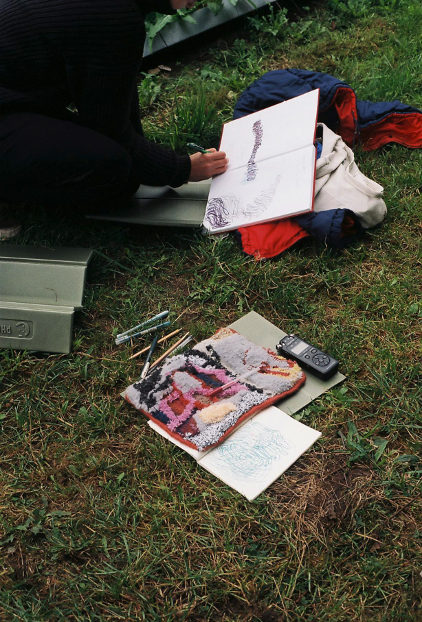
Iiris drawing, recorder catching sounds
Sofie returns and asks us to join her in a big open field, freshly harvested. She lets us watch, and then shows us: “You know the gun shots we have been hearing the entire weekend, of the shooting range near the farm?” She follows their frequent, but unexpected rhythm, and proposes a choreography. With every gunshot she bends to the ground and picks something up, walking until the next <dvv kvv>. The image resembles those of gleaners, who gather produce left behind after a harvest. She reorients the violent shots that have organised the silences between words these past days. Part of the harshness is not knowing who is shooting where. Sofie affirms them, by writing them into the landscape, documenting their rhythm, fielding a composition framed by rapidly expanding propellant gases that force a bullet to accelerate.
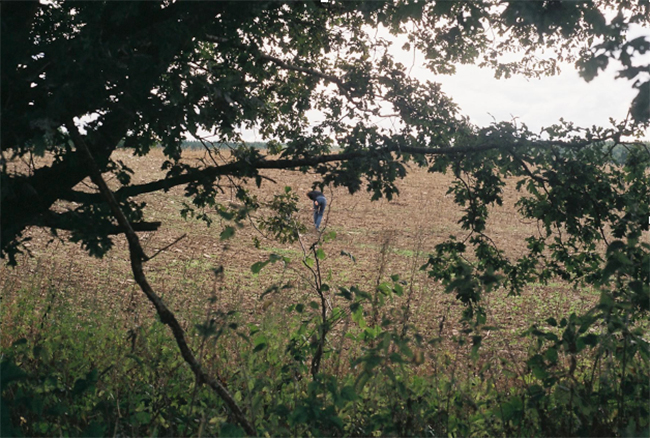
Sofie leads us to the field with her movements
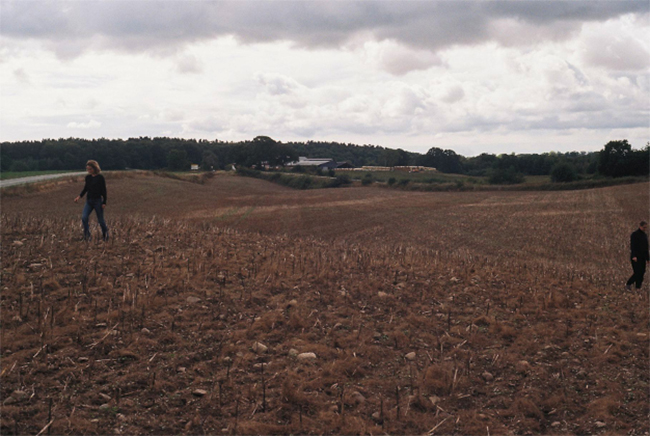 Sofie and Iiris following
Sofie and Iiris following
Iiris tells me she is thinking with invisibility, after practising it for years as a child. She writes with it too. Sofie tells me that her practice always starts and ends with performance writing. On our way to a lake, she invites us to experiment with writing a landscape. I am thinking about how my walking will inform my swimming later. And how the swimming informs my walking, here, now. “Okay, after swimming we’ll practise a bit with being invisible, and then we try some landscape-writing.” Iiris and I swim, waving to Sofie who goes for a walk. The water is cold and sticky. We practise being invisible. We run out of time to landscape-write. We have a long conversation about the tussle of (in)visibility in a world that selectively recognizes personhood.
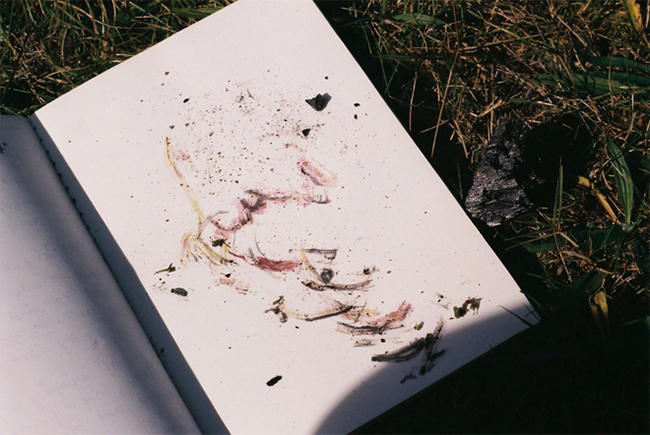
Drawing made with Iiris’ and Sofie’s movements and sounds noted by my hands
A recorder, camera and notebook travelled to All My Relations alongside the text(ile). When practising recording while drawing, the question is: when to turn on the recorder? How does one care for the conditions of capture? How to notice? Not to fall back into a capture or halt the drawing, moving, walking, writing. But the articulation does do something necessary. It somehow both enables the sharing of moments and thinking in process, and it enables returning to the drawing, again, differently. The recording brings out elements which are obscured by temporality and only become foregrounded through the very act of recording and articulating. How to make sharing processual rather than presentational?
-
There is a part of my practice which is an inventory of words and images that resist to be written. It is not because there is no time or concentration, but simply because the conditions for articulation are rare. To attune to what moves between already defined and contained terms follows blogger and autistic-rights activist Mel Baggs, who shows that interactivity with an environment exceeds any form, be that of language, thought, and human (In my Language, 2007). The words and images often spark sideways to other practices: excesses that do not make it to the page, stage, or frame but do shape the work as it comes to be. Although unwritten, the unarticulated writing is very much part of each practice. It evokes questions of how to work with words and images that need other rhythms and conditions, especially within institutional quantitative constructs of time and value. One thing is sure; they are words that do not want to be articulated by one person behind a laptop. They are in need of a collective endeavour, a collective storying, refusing language as a mediator of experience, for survival in a world where relationality is often reduced or disregarded. Navigating this is not always easy, when articulation is expected words do not always follow.
I gave these unarticulated words and unfinished images a working title of sink cinema, referencing an inventory of images and texts that are absorbed and/or reflected by the sink’s stainless steel/marble/stone and spill before draining. Less cinema and more sink, or sync, this nomer positively haunted words and works that did not make it to the page, frame, or stage after seeing a video-screen installed in a sink during an exhibition seven years ago. And just like that: I stumbled upon countless sinks at Gylleboverket, right behind the Folkets Bio (The People’s Cinema).
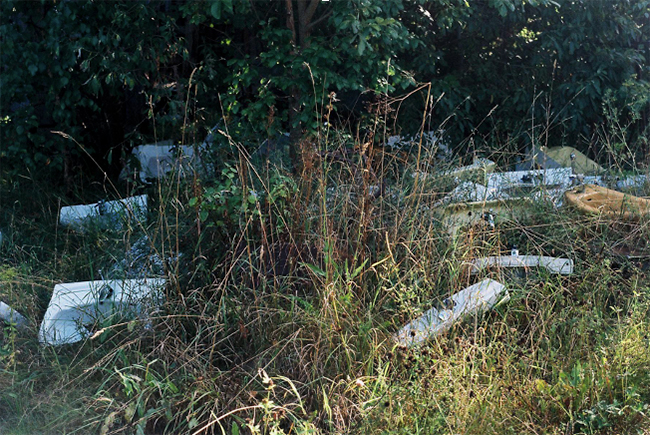
How long have these sinks already been behind the cinema?
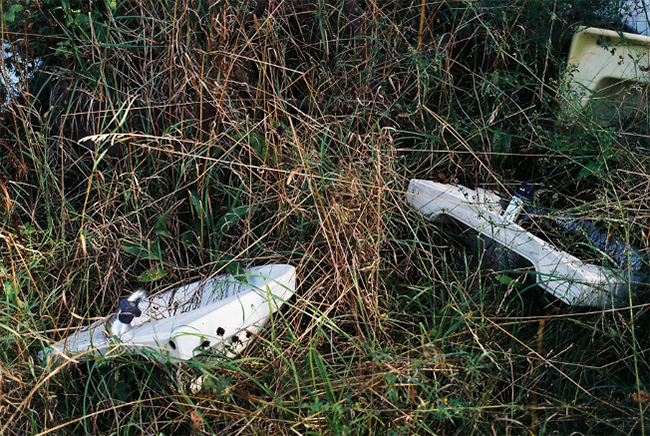
I wonder about all the hands they washed
Sync/sink is a refrain of spills that refrain from articulation and resist registers as memories of the future that immanently question what it is to be countable; what comes to count; what counts as valuable. Such spills and syncs are gifts for future encounters, for potential processes. But they also echo those that go uncountable, that are unaccounted for; those that have been denied language; those that have been framed in a logic of lack. An inventory, a field for stories violently framed or lost, for those who have been denied speech, for those left unread. Language as such is not a mediator of those experiences, but a practice, a way of doing, an active participator in the encounter of word with world, inventing words and worlds to come.
Words surging between activities as mentioned in the first sentence of this text are here moving from one mode of making/thinking to another, not always sure where one ends and the other begins. It is also the social, collective element, where practices are shared and exchanged, where questions of inviting and receiving are formulated, where not only one form of participation is favoured. As such, it exceeds and refuses a work as solely finished, individual and recognizable compositions. Rather, it is a practice for thinking with potential, to not stop tending to what is to come, for composing around and across.
It is important to give momentum to voices and processes that don’t know that they are sharing something yet. To prevent framing activities in advance and putting them in a particular kind of relationality. Rather, pluriform ways and encounters, crafting a new relational field, emerge each time anew. The sinks behind the cinema remind me: it is always uncertain how and when traces pop up again. This is perhaps the force of the social and the experimental in a practice; to wonder how things take shape and inform each other. All My Relations invited novel relations into a sharing of practices so that processes can continue again, here, now, differently.
Keywords
Texture, textile, text, writing, drawing, collectivity, relationality, articulation, documentation, recording, sounds, rawing, collectivity, relationality, articulation, documentation, recording, sounds.
About the Author
Anouk Hoogendoorn is an artistic researcher who studied Image and Language at the Gerrit Rietveld Academie and Artistic Research at the University of Amsterdam. She/they participated in the Senselab/Three Ecologies Institute as well as other collective projects. Hence, the practice always has an important collaborative and experimental orientation to it. Their (spoken) texts, textiles, photos, sketches, videos, and audio works are moments of processes rather than presentations fixed once and for all. At the moment Anouk is part of PEERS, a pre-doc programme at the Institute for the Performing Arts and Film in Zurich.
www.anoukhoogendoorn.com

